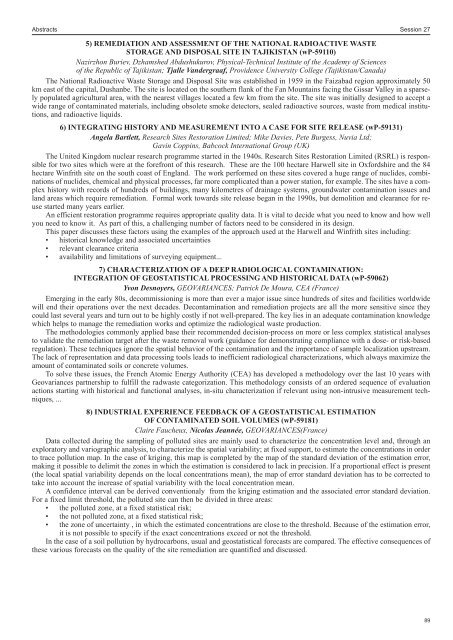ICEM11 Final Program 9.7.11pm_ICEM07 Final Program ... - Events
ICEM11 Final Program 9.7.11pm_ICEM07 Final Program ... - Events
ICEM11 Final Program 9.7.11pm_ICEM07 Final Program ... - Events
Create successful ePaper yourself
Turn your PDF publications into a flip-book with our unique Google optimized e-Paper software.
Abstracts Session 27<br />
5) REMEDIATION AND ASSESSMENT OF THE NATIONAL RADIOACTIVE WASTE<br />
STORAGE AND DISPOSAL SITE IN TAJIKISTAN (wP-59110)<br />
Nazirzhon Buriev, Dzhamshed Abdushukurov, Physical-Technical Institute of the Academy of Sciences<br />
of the Republic of Tajikistan; Tjalle Vandergraaf, Providence University College (Tajikistan/Canada)<br />
The National Radioactive Waste Storage and Disposal Site was established in 1959 in the Faizabad region approximately 50<br />
km east of the capital, Dushanbe. The site is located on the southern flank of the Fan Mountains facing the Gissar Valley in a sparsely<br />
populated agricultural area, with the nearest villages located a few km from the site. The site was initially designed to accept a<br />
wide range of contaminated materials, including obsolete smoke detectors, sealed radioactive sources, waste from medical institutions,<br />
and radioactive liquids.<br />
6) INTEGRATING HISTORY AND MEASUREMENT INTO A CASE FOR SITE RELEASE (wP-59131)<br />
Angela Bartlett, Research Sites Restoration Limited; Mike Davies, Pete Burgess, Nuvia Ltd;<br />
Gavin Coppins, Babcock International Group (UK)<br />
The United Kingdom nuclear research programme started in the 1940s. Research Sites Restoration Limited (RSRL) is responsible<br />
for two sites which were at the forefront of this research. These are the 100 hectare Harwell site in Oxfordshire and the 84<br />
hectare Winfrith site on the south coast of England. The work performed on these sites covered a huge range of nuclides, combinations<br />
of nuclides, chemical and physical processes, far more complicated than a power station, for example. The sites have a complex<br />
history with records of hundreds of buildings, many kilometres of drainage systems, groundwater contamination issues and<br />
land areas which require remediation. Formal work towards site release began in the 1990s, but demolition and clearance for reuse<br />
started many years earlier.<br />
An efficient restoration programme requires appropriate quality data. It is vital to decide what you need to know and how well<br />
you need to know it. As part of this, a challenging number of factors need to be considered in its design.<br />
This paper discusses these factors using the examples of the approach used at the Harwell and Winfrith sites including:<br />
• historical knowledge and associated uncertainties<br />
• relevant clearance criteria<br />
• availability and limitations of surveying equipment...<br />
7) CHARACTERIZATION OF A DEEP RADIOLOGICAL CONTAMINATION:<br />
INTEGRATION OF GEOSTATISTICAL PROCESSING AND HISTORICAL DATA (wP-59062)<br />
Yvon Desnoyers, GEOVARIANCES; Patrick De Moura, CEA (France)<br />
Emerging in the early 80s, decommissioning is more than ever a major issue since hundreds of sites and facilities worldwide<br />
will end their operations over the next decades. Decontamination and remediation projects are all the more sensitive since they<br />
could last several years and turn out to be highly costly if not well-prepared. The key lies in an adequate contamination knowledge<br />
which helps to manage the remediation works and optimize the radiological waste production.<br />
The methodologies commonly applied base their recommended decision-process on more or less complex statistical analyses<br />
to validate the remediation target after the waste removal work (guidance for demonstrating compliance with a dose- or risk-based<br />
regulation). These techniques ignore the spatial behavior of the contamination and the importance of sample localization upstream.<br />
The lack of representation and data processing tools leads to inefficient radiological characterizations, which always maximize the<br />
amount of contaminated soils or concrete volumes.<br />
To solve these issues, the French Atomic Energy Authority (CEA) has developed a methodology over the last 10 years with<br />
Geovariances partnership to fulfill the radwaste categorization. This methodology consists of an ordered sequence of evaluation<br />
actions starting with historical and functional analyses, in-situ characterization if relevant using non-intrusive measurement techniques,<br />
...<br />
8) INDUSTRIAL EXPERIENCE FEEDBACK OF A GEOSTATISTICAL ESTIMATION<br />
OF CONTAMINATED SOIL VOLUMES (wP-59181)<br />
Claire Faucheux, Nicolas Jeannée, GEOVARIANCES(France)<br />
Data collected during the sampling of polluted sites are mainly used to characterize the concentration level and, through an<br />
exploratory and variographic analysis, to characterize the spatial variability; at fixed support, to estimate the concentrations in order<br />
to trace pollution map. In the case of kriging, this map is completed by the map of the standard deviation of the estimation error,<br />
making it possible to delimit the zones in which the estimation is considered to lack in precision. If a proportional effect is present<br />
(the local spatial variability depends on the local concentrations mean), the map of error standard deviation has to be corrected to<br />
take into account the increase of spatial variability with the local concentration mean.<br />
A confidence interval can be derived conventionaly from the kriging estimation and the associated error standard deviation.<br />
For a fixed limit threshold, the polluted site can then be divided in three areas:<br />
• the polluted zone, at a fixed statistical risk;<br />
• the not polluted zone, at a fixed statistical risk;<br />
• the zone of uncertainty , in which the estimated concentrations are close to the threshold. Because of the estimation error,<br />
it is not possible to specify if the exact concentrations exceed or not the threshold.<br />
In the case of a soil pollution by hydrocarbons, usual and geostatistical forecasts are compared. The effective consequences of<br />
these various forecasts on the quality of the site remediation are quantified and discussed.<br />
89
















